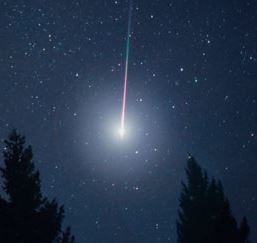The Glorious Geminid Meteor Shower has been viewed by keen stargazers from every corner of Earth again this year. The magical celestial spectacle is a faithful annual visitor, lighting up our skies every year in December as Earth goes through the trail of debris left by 3200 Phatheon, a Palladian asteroid that was discovered on 11th October, 1983, by the Infrared Astronomical Satellite.
As our planet goes through this trail of debris, some of the rocks fall through our atmosphere and burn up, creating the Geminid Meteor Shower, also known as the Geminids.
The show proved a fitting finale to the International Year of Light and Light-based Technologies – a United Nations observance to raise awareness of light science and its achievements, applications and importance to humankind.
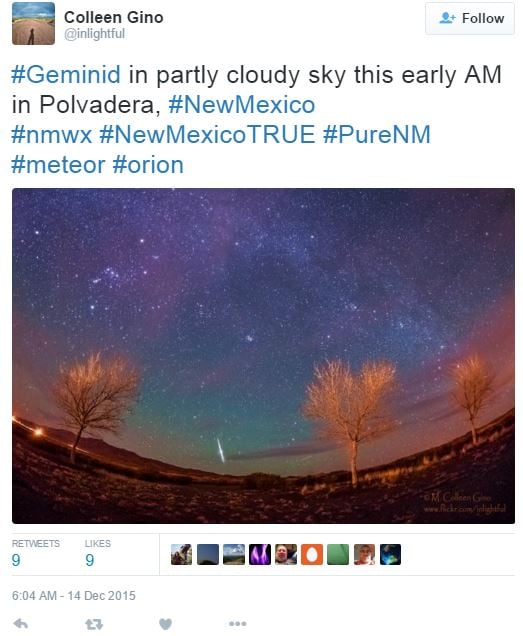 Colleen Gino took this amazing photo in New Mexico, USA, early on Monday morning. (Image: twitter.com/inlightful)
Colleen Gino took this amazing photo in New Mexico, USA, early on Monday morning. (Image: twitter.com/inlightful)
Amateur astronomers, stargazers and others in Europe, Asia, Africa, Australasia and North & South America, who just happened to look up at the night sky, have this week witnessed one of the best and most reliable annual meteor showers, which at its peak brings over 120 meteors whizzing across the sky per hour, according to NASA (UK’s Met Office says 50 per hour).
Geminids originate from an asteroid not a comet
The Geminids are different from most other meteor showers. Along with the Quadrantids, the Geminids are the only major meteor showers that come from asteroids – the others originate from comets.
Meteor showers that come from asteroids are very rocky and gritty, which means they burn up much more brightly, making them easier to see in the sky with the naked eye.
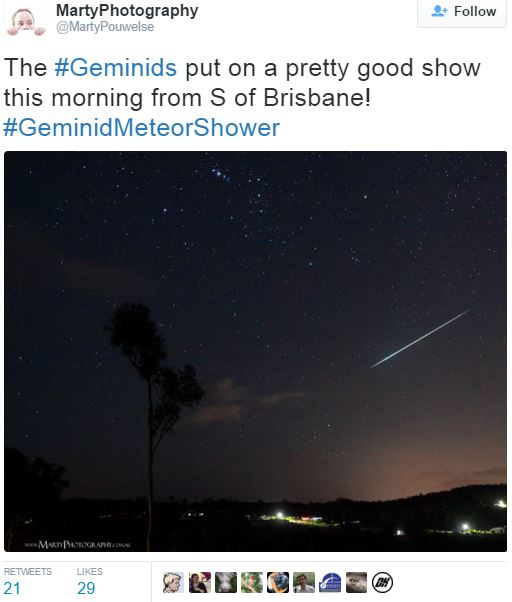 Australian stargazers posted hundreds of super photographs. Look at this one taken by Marty Photography, south of Brisbane, on Monday. (Image: twitter.com/MartyPouwelse)
Australian stargazers posted hundreds of super photographs. Look at this one taken by Marty Photography, south of Brisbane, on Monday. (Image: twitter.com/MartyPouwelse)
Amateur astronomers say the Geminids are great because they streak across the sky super brightly and you do not need to locate the Gemini constellation in order to track them. Even though they come from the Gemini constellation, they flash across the whole sky when they crash down at 22 miles per second (35 km per second), so you cannot miss them!
The National Aeronautics and Space Administration (NASA), America’s space agency, says the Geminids can appear almost anywhere in the night sky, and generally have a yellowish hue.
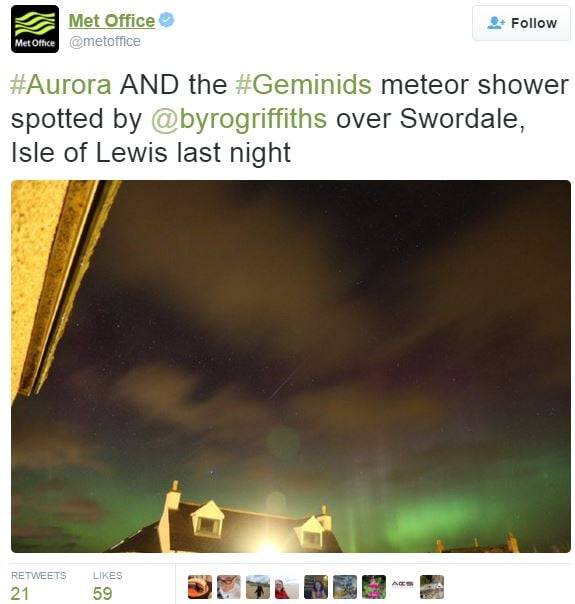 This picture of the Giminids occurring at the same time as the Northern Lights (Aurora Borealis) was taken in the Isle of Lewis in the Outer Hebrides of Scotland. (Image: twitter.com/metoffice)
This picture of the Giminids occurring at the same time as the Northern Lights (Aurora Borealis) was taken in the Isle of Lewis in the Outer Hebrides of Scotland. (Image: twitter.com/metoffice)
No need for telescopes or binoculars
For those in the northern hemisphere, especially if you live far from the equator, all you need to witness the magnificent show are some warm clothes, perhaps a hot drink, a clear sky, and a keen pair of eyes. You don’t need a telescope or binoculars. In fact, with such equipment you might miss much of it – binoculars do not capture the whole sky at once.
NASA’s Jet Propulsion Laboratory had the following advice:
“Put away the telescope or binoculars. Using either reduces the amount of sky you can see at one time, lowering the odds that you’ll see anything but darkness. Instead, let your eyes hang loose and don’t look in any one specific spot.”
“Relaxed eyes will quickly zone in on any movement up above, and you’ll be able to spot more meteors. Avoid looking at your cell phone or any other light. Both destroy night vision.”
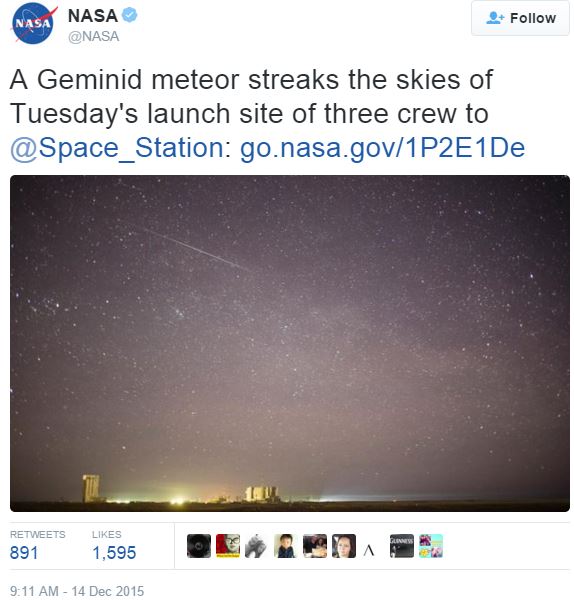 This photo was taken at the Baikonur Cosmodrome in Kazakhstan – the launch site of the Soyuz spacecraft that took Britain’s Tim Peake, Russia’s Yuri Malenchenko and America’s Tim Kopra to the International Space Station on Tuesday. (Image: twitter.com/NASA)
This photo was taken at the Baikonur Cosmodrome in Kazakhstan – the launch site of the Soyuz spacecraft that took Britain’s Tim Peake, Russia’s Yuri Malenchenko and America’s Tim Kopra to the International Space Station on Tuesday. (Image: twitter.com/NASA)
According to the UK Met Office:
“Starting on 4 December and ending on the 17 December, the Geminid meteor shower is for most, the highlight of the meteor shower calendar in 2015. The best time to view the Geminids is between sunset, local time and before sunrise.”
“Star gazers will be looking for clear, cloudless skies to have the best possible chance of catching a glimpse of the meteor shower. Ideally a location away from light pollution will be of benefit.”
NASA said the Geminids peaked during daylight on Monday, December 14th. However, a decent spectacle could be observed on Sunday and Tuesday, from about nine to ten at night.
According to the Houston Museum of Natural Science, the Geminid Meteor Shower was first observed in 1862. At that time it was not such a great spectacle, with just ten to twenty meteors per hour at its peak. They have intensified each year since then, and will continue to do so.
Video – Geminid Meteor Shower captured on film

